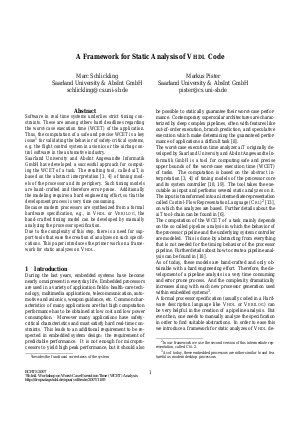A Framework for Static Analysis of VHDL Code
Authors Marc Schlickling, Markus Pister
-
Part of:
Volume:
7th International Workshop on Worst-Case Execution Time Analysis (WCET'07) (WCET 2007)
Part of: Series: Open Access Series in Informatics (OASIcs)
Part of: Conference: Workshop on Worst-Case Execution Time Analysis (WCET) - License:
 Creative Commons Attribution-NonCommercial-NoDerivs 3.0 Unported license
Creative Commons Attribution-NonCommercial-NoDerivs 3.0 Unported license
- Publication Date: 2007-11-13
File

PDF
OASIcs.WCET.2007.1189.pdf
- Filesize: 105 kB
- 6 pages
Document Identifiers
Subject Classification
Keywords
- Timing Analysis
- Worst-Case Execution Time
- VHDL
- Static Analysis
Metrics
- Access Statistics
-
Total Accesses (updated on a weekly basis)
0PDF Downloads0Metadata Views
Abstract
Software in real time systems underlies strict timing constraints. These are among others hard deadlines regarding the worst-case execution time (WCET) of the application. Thus, the computation of a safe and precise WCET is a key issue1 for validating the behavior of safety-critical systems, e.g. the flight control system in avionics or the airbag control software in the automotive industry. Saarland University and AbsInt Angewandte Informatik GmbH have developed a successful approach for computing the WCET of a task. The resulting tool, called aiT, is based on the abstract interpretation [3, 4] of timing models of the processor and its periphery. Such timing models are hand-crafted and therefore error-prone. Additionally the modeling requires a hard engineering effort, so that the development process is very time consuming. Because modern processors are synthesized from a formal hardware specification, e.g., in VHDL or VERILOG, the hand-crafted timing model can be developed by manually analyzing the processor specification. Due to the complexity of this step, there is a need for support tools that ease the creation of analyzes on such specifi- cations. This paper introduces the primer work on a framework for static analyzes on VHDL.
Cite As Get BibTex
Marc Schlickling and Markus Pister. A Framework for Static Analysis of VHDL Code. In 7th International Workshop on Worst-Case Execution Time Analysis (WCET'07). Open Access Series in Informatics (OASIcs), Volume 6, pp. 1-6, Schloss Dagstuhl – Leibniz-Zentrum für Informatik (2007)
https://doi.org/10.4230/OASIcs.WCET.2007.1189
BibTex
@InProceedings{schlickling_et_al:OASIcs.WCET.2007.1189,
author = {Schlickling, Marc and Pister, Markus},
title = {{A Framework for Static Analysis of VHDL Code}},
booktitle = {7th International Workshop on Worst-Case Execution Time Analysis (WCET'07)},
pages = {1--6},
series = {Open Access Series in Informatics (OASIcs)},
ISBN = {978-3-939897-05-7},
ISSN = {2190-6807},
year = {2007},
volume = {6},
editor = {Rochange, Christine},
publisher = {Schloss Dagstuhl -- Leibniz-Zentrum f{\"u}r Informatik},
address = {Dagstuhl, Germany},
URL = {https://drops.dagstuhl.de/entities/document/10.4230/OASIcs.WCET.2007.1189},
URN = {urn:nbn:de:0030-drops-11891},
doi = {10.4230/OASIcs.WCET.2007.1189},
annote = {Keywords: Timing Analysis, Worst-Case Execution Time, VHDL, Static Analysis}
}
